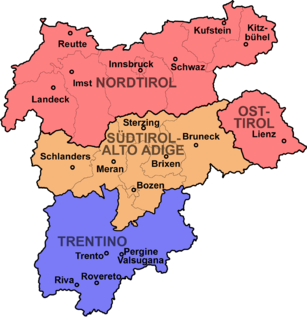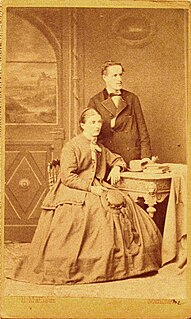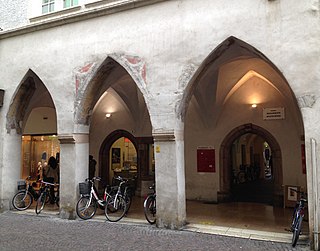Related Research Articles

South Tyrol is an autonomous province in northern Italy, one of the two that make up the autonomous region of Trentino-Alto Adige/Südtirol. Its official trilingual denomination is Autonome Provinz Bozen – Südtirol in German, Provincia autonoma di Bolzano – Alto Adige in Italian and Provinzia autonoma de Bulsan – Südtirol in Ladin, reflecting the three main language groups to which its population belongs. The province is the northernmost of Italy, the second largest, with an area of 7,400 square kilometres (2,857 sq mi) and has a total population of 531,178 inhabitants as of 2019. Its capital and largest city is Bolzano.

Bolzano is the capital city of the province of South Tyrol in northern Italy. With a population of 108,245, Bolzano is also by far the largest city in South Tyrol and the third largest in Tyrol. The greater metro area has about 250,000 inhabitants and is one of the urban centers within the Alps.

Trentino-Alto Adige/Südtirol is an autonomous region of Italy, located in the northern part of the country. Since the 1970s, most legislative and administrative powers have been transferred to the two self-governing provinces that make up the region: the Province of Trento, commonly known as Trentino, and the Province of Bolzano, commonly known as South Tyrol.

Brixen is a town in South Tyrol in northern Italy, located about 40 kilometres (25 mi) north of Bolzano.

Neumarkt is a comune (municipality) in South Tyrol in northern Italy, located about 25 kilometres (16 mi) south of the city of Bolzano.

The South Tyrol Option Agreement was an agreement in effect between 1939 and 1943, when the native German speaking people in South Tyrol and three communes in the province of Belluno were given the option of either emigrating to neighboring Nazi Germany or remaining in Fascist Italy and being forcibly integrated into the mainstream Italian culture, losing their language and cultural heritage. Over 80% opted to move to Germany.

Modern-day South Tyrol, an autonomous Italian province created in 1948, was part of the Austro-Hungarian County of Tyrol until 1918. It was annexed by Italy following the defeat of the Central Powers in World War I. It has been part of a cross-border joint entity, the Euroregion Tyrol-South Tyrol-Trentino, since 2001.

The Ritten Railway is an electric light railway which originally connected Bolzano with the Ritten plateau and today continues to operate on the plateau, connecting the villages located there.

Josef Theodor Moroder, also known as the Lusenberger, was a painter and sculptor, the most prominent artist of the Moroder family from the Grödenthal in South Tyrol.

Bolzano was a transit camp operated by Nazi Germany in Bolzano from 1944 to 3 May 1945 during World War II. It was one of the largest Nazi Lager on Italian soil, along with those of Fossoli, Borgo San Dalmazzo and Trieste.

In 1919, at the time of its annexation, the middle part of the County of Tyrol which is today called South Tyrol was inhabited by almost 90% German speakers. Under the 1939 South Tyrol Option Agreement, Adolf Hitler and Benito Mussolini determined the status of the German and Ladin (Rhaeto-Romanic) ethnic groups living in the region. They could emigrate to Germany, or stay in Italy and accept their complete Italianization. As a consequence of this, the society of South Tyrol was deeply riven. Those who wanted to stay, the so-called Dableiber, were condemned as traitors while those who left (Optanten) were defamed as Nazis. Because of the outbreak of World War II, this agreement was never fully implemented. Illegal Katakombenschulen were set up to teach children the German language.

Oskar Peterlini, Lecturer at the Free University of Bozen Bolzano, is a Representative of the German-speaking South Tyrolean Minority in South Tyrol, Italy. He was a member of the Italian Senate in the Italian Parliament from 2001 to 2013, Member of the Regional Parliament of Trentino South Tyrol from 1978 to 1998 and its president from 1988–1998. He was also President of the district of the South Tyrolean Unterland of the South Tyrolean People's Party (SVP) from 2001 to 2010.

Bolzano/Bozen railway station is the main station of Bolzano/Bozen, capital of the autonomous province of Alto Adige/Südtirol, in northeastern Italy.

Trento railway station is the main station of Trento, capital of the autonomous province of Trentino, in northeastern Italy.

Brenner railway station is the border station of Italy and Austria. It serves the town and comune of Brenner in the autonomous province of South Tyrol, northeastern Italy.

Tyrol is a historical region in the Alps—in Northern Italy and western Austria. The area was historically the core of the County of Tyrol, part of the Holy Roman Empire, Austrian Empire and Austria-Hungary, from its formation in the 12th century until 1919. In 1919, following World War I and dissolution of Austria-Hungary, it was divided into two modern administrative parts through the Treaty of Saint-Germain-en-Laye:
Hans Karl Peterlini is an author, journalist, university professor and educational researcher originally from South Tyrol, an autonomous, mostly German speaking province in Northern Italy.
The following is a timeline of the history of the city of Bolzano/Bozen in the Trentino-South Tyrol region of Italy.

The Civic Archives in Bozen-Bolzano are the municipal archive of the city of Bolzano in South Tyrol, Italy. They are located in the old town hall and store documents from over 700 years of civic and regional history.

The cathedral Maria Himmelfahrt is the parish church of the South Tyrolean capital Bozen and cathedral of the Roman Catholic Diocese of Bozen-Brixen. While the Bishop has resided in Bozen since 1964, the cathedra and the cathedral chapter remain in Brixen. Maria Himmelfahrt is therefore with Brixen Cathedral co-cathedral of the diocese.
References
- 1 2 3 Die Südtirolfrage, Institute of contemporary history; University of Innsbruck; Rolf Steininger
- 1 2 A brief contemporary history of Alto Adige/Südtirol (1918-2002), Parliament of the Autonomous Province of Bolzano/Bozen
- ↑ Zimmermann, Z., Ein Besuch in Bozen/Italien (Onde 24/2005), Saarbrücken
- ↑ Angela Nikoletti, Frauen-Biographieforschung e.V. - Institut für Frauen-Biographieforschung, Hannover